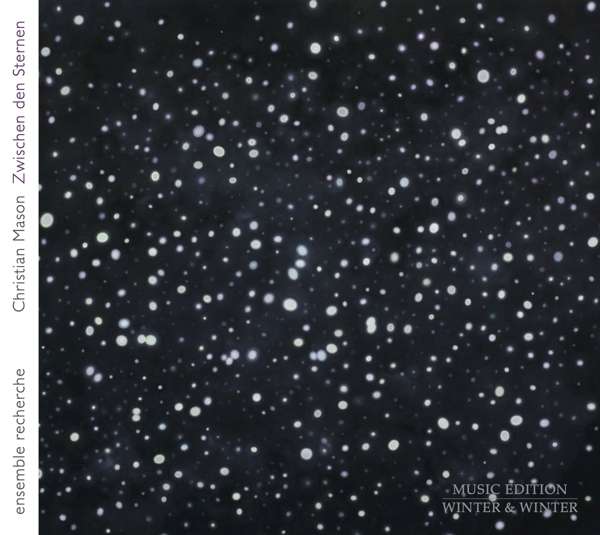Christian Mason’s composition »Zwischen den Sternen«, inspired by Rainer Maria Rilke’s poem with the same name, is the result of intensive exchange and close collaboration with the musicians of ENSEMBLE RECHERCHE. Mason leaves the Well-Tempered Tonality, works with scordatura to let floating states emerge and disappear, and uses instruments such as the steel drum or swinging snare drums. At the tonal center is the piano with an enraptured mood that seems to flicker. Mason works four-dimensionally with space and time. Sounds move along their paths like meteors, fade away and dive into infinity. He composes tones, noises and creates again and again new spaces in the course of time. Christian Mason: „It is important to remember the stars because they put things in perspective. For a start, the specks of light we see at night – coming from across the universe – began before we existed. The actual distance between the stars is almost incomprehensible, yet from our faraway earth-bound perspective they appear in close clusters and constellations. The mysterious relationship between proximity and perspective – millions of light years seemingly within the span of a hand! This might induce anxiety, or awe, yet equally the stars offer a comforting sense of constancy (even if they do sometimes explode into supernovae and change the structure of the sky). The music connects to these thoughts through the mediating filter of Rilke’s poem of the same name, number XX of the Second Part of his Sonnets to Orpheus, which I read translated in the Norton edition. Rilke humanises the cosmic expanse by analogy, comparing it initially to the distance between two children, and then the ‘many spans merely from a maid to a man, when she avoids him and has him in mind.’ In so doing he magnifies the sense of scale inherent in human feelings and relationships, drawing our attention to the solitude of emotional distance. Physical space might be vast, but emotional space seems vaster… These twin notions of distance and relationship are key to understanding the musical world of »Zwischen den Sternen«. The most direct analogy is in the evolving spatial distribution of the musicians. With each spatial reconfiguration, the players form new musical relationships which unambiguously serve to define the sound and form of the piece. But there is also a sense of space in the harmony, especially in the opening dyads: empty yet full of feeling, with a melancholy twist that comes from the spectral re-tuning of six notes of the piano to partials 7, 11, 13, 14, 21 and 23 of a C-spectrum. This re-tuning is matched by the string trio who double on scordatura instruments: violin with four G-strings, viola with 2 G- and 2 C-strings, cello with four A-strings. These instruments, with their unique resonances, become the defining feature of the music from movement IV until the end of the piece, when the cellist is left alone on stage, absorbed in an ecstatic semi-improvisation while the others wistfully process out into the distance… But on reflection maybe the most starry aspect of the piece comes earlier with the wonderful sound of the steel drum: exploding constellations of notes blooming and fading, bright yet evanescent, a sonic microcosm of the distant stars and the space between them.“ „In my experience there are few things more beautiful than sounds in the distance – the tantalising horizon of hearing! Here – in »Zwischen den Sternen« – distance becomes the subject (musical and extra-musical): abstract sounds explore the emotional proximity of people and the vibrant space between musicians. The varied sonic materials that float and glide through the piece reach us from different directions, defining a slow ritual of coalescence and dispersal through the time and space of performance. Though here (on a recorded work) we cannot see the movements of the musicians, we can still be absorbed in the depths and delicacies of their sounds: the flute like a wisp of cloud; the crystal bowl with its own resonant rhythm; the steel drum like a spark of light; the piano with a misty veil of melancholy microtones; the scordatura cello with an ecstasy of harmonics… Music which sometimes seems so close that you can almost touch it, and at other times so far that you wonder where it is coming from.“ This is the second Winter & Winter recorded work with ENSEMBLE RECHERCHE after Hans Abrahamsen’s highly successful piece »Schnee« (Winter & Winter 910 159-2). Christian Mason is a composer laureate of the Ernst von Siemens Music Foundation. Paul Griffiths, librettist of Hans Abrahamsen’s song cycle »let me tell you« (Winter & Winter 910 232-2), wrote the text for the Ernst von Siemens Music Foundation’s award of the Composer’s Prize to Christian Mason: https://www.evs-musikstiftung.ch/de/preise/preise/komponistenpreistrager/christian-mason.html The composition »Zwischen den Sternen« is a commissioned work by ENSEMBLE RECHERCHE, financed by the Ernst von Siemens Music Foundation. The recording is sponsored by PRS Foundation, London and supported by RVW-Trust. |
